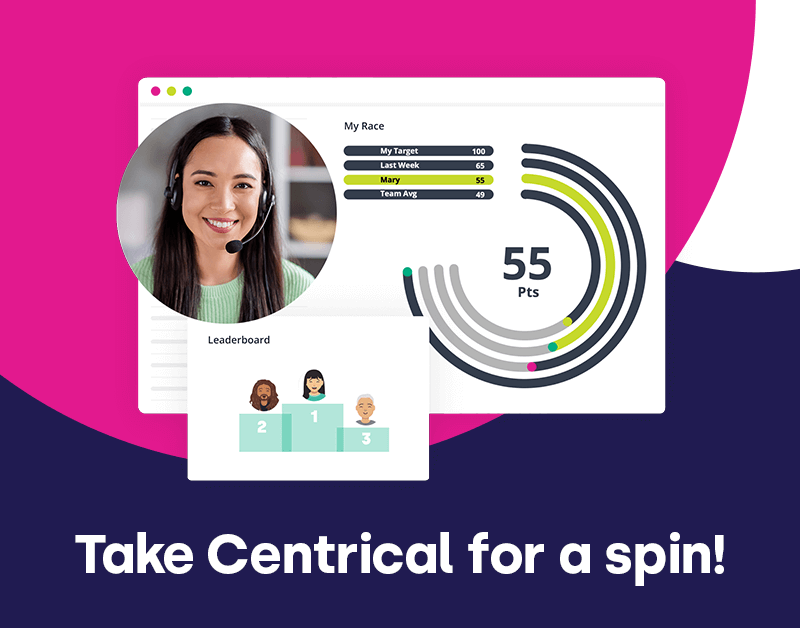This article was originally published as part of Centrical CEO and founder Gal Rimon’s “The Future of Work” newsletter. For more insights on CX, EX, and industry thought leadership, subscribe today and follow Gal on LinkedIn.
The Day I Saw My Performance in Real Time
I’ve been swimming for years. For a while, I thought I was doing everything right: swimming steady, consistent laps, and pushing myself just enough to feel like I was improving. But the truth was, my performance was inconsistent, and I didn’t even realize it.
Until I had a conversation about swimming with Brian Snyder of CellularSales, one of our strategic customers and an amateur swimmer himself, who told me about FORM smart goggles. These augmented reality goggles project real-time performance metrics—including swim distance, pace, and heart rate—directly onto the lens, allowing swimmers to adjust their performance as they train.
Intrigued, I bought a pair. The impact was immediate. With performance tracking, real-time feedback, and achievement recognition, I improved my pace and saw tangible progress. Also the High-Intensity Interval Training (HIIT) method greatly helped me improve my stamina.
That’s when it clicked: this was gamification in action. It made me realize that most employee engagement programs operate like my old swimming routine—slow, repetitive, and lacking the real-time insights needed for meaningful improvement. After all, high-performance athletes don’t train that way, and neither should your employees.
What Elite Athletes Know About Performance (That Most Companies Don’t)
More recently, FORM launched a new set of premium coaching features, which changed the game once again. The system analyzed my swim and revealed that to improve my performance, I had to change a set of behaviors, such as my breathing technique. It measured behaviors such as:
- Head Pitch: the angle at which you look up or down while swimming with your face in the water. You should aim for 30-37 degrees.
- Peak Head Roll: the maximum angle of the side-to-side roll of your head when breathing. The lower, the better.
- Time-to-Neutral: the percentage of your breath time spent returning to neutral after you inhale.
Think about it: If you focus only on the outcomes—such as speed and distance—without addressing the behaviors that drive them, you won’t get far. You can say “swim faster,” but the real question is, “how?”
The same applies to your team’s performance: if you focus only on their KPIs without addressing the underlying behaviors driving those results, performance is unlikely to improve much.
Performance Isn’t Just About Metrics. It’s About Behaviors
Too often, organizations track high-level performance metrics while overlooking the underlying behaviors driving them. But metrics alone don’t create change! Targeted behavioral adjustments, however, do.
Let’s consider two contact center-specific examples.
Example: Low Sales Conversion Rate
If a contact center agent is struggling to meet her sales conversion KPI, she can’t be expected to improve purely by seeing her missed target. Asking someone to sell more is not enough. They must understand the behavior driving their performance gap. In this case, the agent may not be consistently asking probing questions to uncover customer needs. Without targeted feedback and coaching, she’s likely feeling unsuccessful, disengaged, and unmotivated.
The solution? Shadow call coaching, simulations, and gamified challenges will help her learn and practice effective sales techniques, such as asking the right questions at the right time.
Example: Low Customer Satisfaction (CSAT) Score
If an agent’s CSAT score drops, the root cause could be a lack of active listening or empathy during customer interactions. In this case, targeted actions might include AI-driven coaching on listening skills, role-playing exercises to practice empathy, or a gamified challenge focused on using positive language.
By linking performance insights to behavior-driven coaching, organizations can create meaningful improvements beyond numbers.
From Data to Action: How Behavioral Coaching Changes the Game
Just like FORM goggles analyze my breathing and provide guided training to correct it, frontline managers need data-driven coaching insights to help employees improve their skills.
With AI-powered performance management and coaching, companies can:
✅ Pinpoint behavioral gaps that impact performance.
✅ Deliver personalized coaching targeted to specific needs instead of generic training.
✅ Measure the impact of behavior changes over time.
Instead of broad training sessions that don’t stick, coaching can be precise, data-driven, and action-oriented.
And, of course, gamification is key to addressing those coveted behavioral changes!
Stop Swimming in Circles. Start Training to Win.
The day I started identifying my weaknesses and correcting my technique, my swimming performance transformed.
The same holds true in the workplace—tracking metrics alone won’t drive improvement. The real question is: What behaviors need to change to achieve better results? By focusing on behavior-driven coaching, organizations can turn insights into action, helping employees improve faster, smarter, and with lasting impact.
Curious to learn how Centrical keeps the human experience central while leveraging AI? Discover more about our innovative solutions and strategies that bridge technology and the power of human connection.
Engage and motivate your frontline teams
Improve performance with an AI-powered digital coach
Deliver world class CX with dynamic, actionable quality evaluations
Boost performance with personalized, actionable goals
Nurture employee success with the power of AI
Listen and respond to your frontline, continuously
Drive productivity with performance-driven learning that sticks
Drive agent efficiency, deliver client results
Keep tech teams motivated and proficient on products and services while exceeding targets
Maintain compliance while building customer happiness and loyalty
Enlighten energy teams to boost engagement
Engage, develop, and retain your agents while driving better CX
Improve the employee experience for your reservations and service desk agents







 Madeleine Freind
Madeleine Freind
 Natalie Roth
Natalie Roth Linat Mart
Linat Mart












 Doron Neumann
Doron Neumann Gal Rimon
Gal Rimon Daphne Saragosti
Daphne Saragosti Ella Davidson
Ella Davidson Ariel Herman
Ariel Herman Ronen Botzer
Ronen Botzer